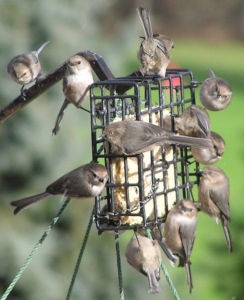The Winter Garden
Here in the Bay Area, we enjoy a climate that makes outdoor living possible in every season. The coldest weeks of winter might be spent inside, true, but even on the shortest days of the year your garden can be enjoyed! Is it possible to have a beautiful winter garden? We think so. In fact, winter gardens can have a striking beauty unique unto themselves. With a landscape plan and a few creative touches, winter may become a new favorite season in your garden!
Winter Structure
Winter is the time when things return to their most elemental. With minimal sunlight and colder weather, many plants reduce themselves to their most simple state. Leaves, flowers, or even the entire visible plant may shrivel and drop to the ground. Only plants that have adapted to wait out the winter with all leaves and stems attached appear alive. These are what we call evergreens, and they have a powerful presence in the winter garden. Those deciduous woody plants whose bare branches remain also have presence. Stripped of all leafy distraction, their form shines through in beautiful branch structure, bark texture, and color.

This evergreen landscape keeps all-season structure, but it could benefit from some looser-structured, flowering plants to break up the green.

Red-twig Dogwood is a lovely addition to the winter landscape. After it loses its leaves, the color it offers is stunning in contrast to winter greens.
When planning a garden that will maintain winter interest, these plants are a great resource. Winter structure, or what remains after everything else has been cut back, gives stability to the garden and provides unique beauty in the transition period from fall to spring. When we design, we incorporate both winter interest plants and seasonal perennials that will shine during the warmer seasons.

These deciduous salvias and peonies vanish completely in the winter, and would benefit from a backdrop of evergreen foliage.
Winter Flower
Believe it or not, there are some spectacular flowers that emerge only in winter here in the Bay. Fragrant Daphne and Sarcococca (Sweet Box) choose late winter to fill the air with fragrance. Camellias are a classic favorite, and their preference for flowering in late winter makes them a great addition to the garden. If you feel them to be old-fashioned and boring, try a sasanqua varietal- the unique open flowers and deep evergreen leaves may win you over.

Camellia sasanqua ‘Setsugekka’ is a favorite for winter flowers in shade.
Cyclamen have become perhaps the most sought-after winter bulb. Though expensive to buy, remember that they will live and flower year after year if left in place in the garden. A carpet of cyclamen flowers can delight under a winter tree or in a border. They make great additions to winter pots, and their ever-growing range of colors accommodates almost any color theme.

Winter Embellishments
The best parts of your winter garden don’t have to be planted at all. Take advantage of the seasonal simplicity in the landscape to show off trees or elements with lights, explore the possibility of adding boulders or a fountain to an area in need of interest, and bring a lively show to your yard by installing bird-feeders for migrating birds. The joys of outdoor living are often the simple ones. Enjoy the season for all it has to offer!

Photo: The Audobon Society
~From all of us here at Montgomery Robbins, we wish you a happy holiday season and a bright new year! Our clients are the best part of our work and we couldn’t create without you. Thank you!






